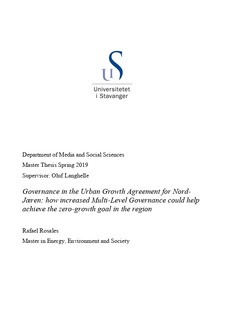| dc.contributor.advisor | Langhelle, Oluf | |
| dc.contributor.author | Rosales La Torraca, Rafael | |
| dc.coverage.spatial | Norway, Nord-Jæren | nb_NO |
| dc.date.accessioned | 2019-10-13T16:35:29Z | |
| dc.date.available | 2019-10-13T16:35:29Z | |
| dc.date.issued | 2019-06 | |
| dc.identifier.uri | http://hdl.handle.net/11250/2621778 | |
| dc.description | Master's thesis in Energy, Environment and Society | nb_NO |
| dc.description.abstract | Urban transport policy has been lifted by the Norwegian government as a way to reduce greenhouse gas emissions from the transport sector in recent years. This has happened at the same time as reports by the Intergovernmental Panel on Climate Change (IPCC) and by Norwegian academia underline the importance of good governance of climate policy. Urban Growth Agreements and similar national schemes have aimed to reduce transport emissions and to improve national transport infrastructure, but this study concludes that the structure of the current Agreements is preventing them from being successful. These Agreements have one main goal: to prevent that growth in the transport sector continues to be dominated by private cars. This is called the zero-growth goal and it aims to reduce transport emissions in Norway. The main question of this thesis is therefore:
Could increased Multi-Level Governance in the Urban Growth Agreement for Nord-Jæren help achieve the zero-growth goal in the region?
It considers the Multi-Level Governance framework outlined by the IPCC and others to better understand whether the structure of the Urban Growth Agreement in Nord-Jæren has led to the current level of disagreement in this region. In Nord-Jæren, in Southwestern Norway, an agreement between four municipalities, the regional government, and the Norwegian State has faced divisions between the different parties. Local parties to the agreement have been unable to agree on the terms they want to negotiate with the State, and the State has created tensions with the local parties by setting stricter budgetary requirements and distancing itself from decisions made locally. Both groups in the agreement have also been influenced by recent social movements against road tolls at a national level. This study concludes that the current governance structure for the Urban Growth Agreement for Nord-Jæren is top-down and hierarchical, and therefore a lack of vertical cooperation between national and local actors has contributed to a pause in renegotiations for this Agreement. It recommends that communications between the national and the local actors improves so that coordination between the actors in the Agreement contributes towards the zero-growth goal. | nb_NO |
| dc.language.iso | eng | nb_NO |
| dc.publisher | University of Stavanger, Norway | nb_NO |
| dc.relation.ispartofseries | Masteroppgave/UIS-SV-IMS/2019; | |
| dc.rights | Navngivelse 4.0 Internasjonal | * |
| dc.rights.uri | http://creativecommons.org/licenses/by/4.0/deed.no | * |
| dc.subject | energi og miljø | nb_NO |
| dc.subject | samfunn | nb_NO |
| dc.subject | byvekstavtale | nb_NO |
| dc.title | Governance in the Urban Growth Agreement for Nord-Jæren: how increased Multi-Level Governance could help achieve the zero-growth goal in the region | nb_NO |
| dc.type | Master thesis | nb_NO |
| dc.subject.nsi | VDP::Social science: 200 | nb_NO |

